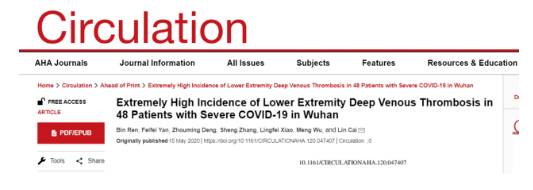The reason for the high case fatality ratio (CFR) in critical COVID-19 patients is not completely clear. Through the screening and clinical research on 48 patients enrolled from the Intensive Care Unit (ICU) of Zhongnan Hospital of WHU and Leishenshan Hospital, it was found that the incidence of deep vein thrombosis (DVT) in critically ill patients was as high as 85.4%, which may contribute to the high mortality or poor prognosis for patients with severe COVID-19. The results were published online recently in Circulation, IF:23, a top cardiovascular journal.

48 cases of patients with severe COVID-19 were analyzed by Zhao Yan (vice president of Zhongnan Hospital of WHU), Shang Dong (vice president of Leishenshan Hospital), and Prof. Cai Lin’s team (Department of Spine and Bone Tumor Surgery, Zhongnan Hospital of WHU). All patients received anticoagulation therapy with subcutaneous injection of low molecular weight heparin (LMWH) once a day, except one with anticoagulation contraindication. However, even with drug thromboprophylaxis, lower extremity DVT was detected in 41 patients (85.4% of the total), among these were 36 (75%) with isolated distal DVT and 5 (10.4%) with proximal DVT. All patients exhibited abnormal levels of inflammatory indicators, including an elevation of neutrophil count and a reduction of lymphocyte count. Of the 29 patients who received mechanical ventilation, 18 had endotracheal intubation.
During the 2003 SARS pandemic, the incidences detected during autopsy of deep vein thrombosis (DVT) and pulmonary embolism (PE) were 20.5% and 11.4%, respectively. A Prophylaxis for Thromboembolism in Critical Care Randomized Trial showed that the rate of lower extremity VTE for patients receiving heparin as anticoagulation was about 5%. Even in critically ill patients with H1N1 infection, the incidence of lower extremity DVT was 12.7%. However, in this investigation, the overall rate of developing DVT in patients receiving ICU treatment due to COVID-19 was much higher than what was shown previously.
Severe infection and inflammation might be important contributors to the development of DVT in patients with severe COVID-19. The high level of neutrophilia counts may be related to the cytokine storm induced by virus infection, while coagulation activation could also have been associated with a sustained inflammatory response. Besides the infection itself, complete bedrest, mechanical ventilation, and venous catheterization are also possible factors that contribute to the high risk of thrombosis observed in the critically ill COVID-19 patients. As to why SARS-COV-2 infection leads to such a high incidence of DVT, more basic studies are needed to explain the mechanism in the future.
The low incidence of proximal DVT may be attributed to LMWH as prophylactic anticoagulation during hospitalization. Although the risk of PE caused by distal DVT is lower than that of proximal DVT, the previous findings also indicate that most of the thrombi originated from the calf tendon and spread upward. Therefore, the clinical relevance of distal DVT should not be ignored, and timely evaluation of DVT as well as preventive measures against PE are necessary for the treatment of patients with severe COVID-19. Especially for recently discharged critically ill COVD-19 patients, continuous attention should be paid to their symptoms of DVT in lower extremities during the later rehabilitation process to avoid life-threatening adverse events such as pulmonary embolism caused by DVT.
This study is the first to report the high incidence of lower extremity deep venous thrombosis (DVT) in patients with severe COVID-19 internationally, providing a new direction for further research on the cause of death and pathogenesis of COVID-19 patients in the future, and offering guidance for the treatment of critically ill COVID-19 patients as COVID-19 continues to spread globally.
Link to paper: https://doi.org/10.1161/CIRCULATIONAHA.120.047407
Rewritten by: Wu Buer
Edited by Zhu Tong, Sylvia and Hu Sijia